How To Make A Paint Wash
Using washes when painting your miniatures tin can salvage y'all a ton of time. They're dandy at quickly shading a model to give it depth, and it's really piece of cake to practice. It's perfect if you lot've got to batch paint a lot of stuff, or y'all but want to salve some time.
Similar anything in miniature painting, there'southward a few tips and tricks that will become a long style to helping you go the upshot you lot want.
I'll show you how to wash your miniatures and share what I've learned over the years. Using washes isn't complicated, simply there are a few little tips and tricks that will help yous achieve the all-time upshot.
Disclosure: Some of the links below are chapter links, meaning, at no additional cost to you, I will earn a commission if yous click through and brand a purchase. The commission earned helps maintain this site.
Where Do You lot Buy Washes?
First things start, where exercise you buy washes for your miniatures?
You can discover them at pretty much any local gaming shop. The ones you lot'll near normally run into are from Citadel/Games Workshop. They come up in alpine pots. Another popular line yous'll often detect is from The Army Painter, likewise as those from Vallejo.
For the most function, miniature washes are the same regardless of who makes information technology. Some are a little dissimilar from others, just the objective of each one is the same, even if they have dissimilar coverage or behavior. And then, don't worry virtually who makes it and buy whatever is available to y'all.
If you're on a budget, or just can't afford to buy every wash all at once (basically well-nigh of united states), then you tin get away with just having a black wash and brown launder for most everything. Those are the two I recommend first, and from at that place just buy what you can when you can.
Having a light-green launder and sepia launder are also very handy. Almost of the other colors are very situational, only useful to accept at some betoken.
I also wanted to mention the gloss washes that Citadel has. If you lot're sealing your miniatures, which you really need to exist doing, then at that place's no bespeak in getting a gloss launder. Once you seal the miniature it will tone down the glossy event.
If yous desire a glossy look on something, then after the miniature is sealed y'all can utilize a brush on gloss varnish for the areas yous want shiny.
Now, hither's a bang-up video by Vince Venturella where he talks nigh, and shows, the departure between the different washes and inks for miniatures by unlike companies.
What is a Wash?
So, what is a wash exactly?
Well, yous can remember of it every bit thinned out paint. Information technology's very watery and you won't use it in the aforementioned manner as a normal paint.
The fashion it works is that when you utilise it to a model, the wash will build up in areas that have seams or depth to it. Then, when it dries, those areas where information technology was the heaviest will have a darker shade to them.
Run across, with a wash existence so thin and watery, when your brush goes over the model it will naturally pool up in edges, seems, textured areas, and deeper areas to create a natural looking shade.
Depending on how thick you use a wash volition depend on how long it takes to dry. If you go actually heavy so it tin can take an hour to dry. Near of the time though, you lot won't be going that heavy, and it should dry in about fifteen minutes, fifty-fifty less sometimes.
Quick Tip: Let a wash fully dry earlier painting over it. If information technology's not fully dry then you will lift up the paint with your brush and ruin the area.
How to Use a Wash
You'll desire to load up your castor pretty heavily with the wash. I like to use the Citadel Medium Shade Brush for virtually things I work on. The advantage of the shade brush is that it has a large belly. And so, it tin can hold a lot more than compared to a standard layer or detail brush.
Even so, you can use a normal layer brush likewise; I did for years and years.
Once your brush is loaded you'll want to drag your brush over the miniature to eolith the wash. Now, the manner yous want to exercise this is past dragging the castor into and upwards against the areas that should accept the nearly shading.
Permit'south say you lot take a cloak you're working on. You lot'll want to drag the brush towards the folds of the cloak. What that will practise is go out the wash on the sides of the fold where it should exist darker.

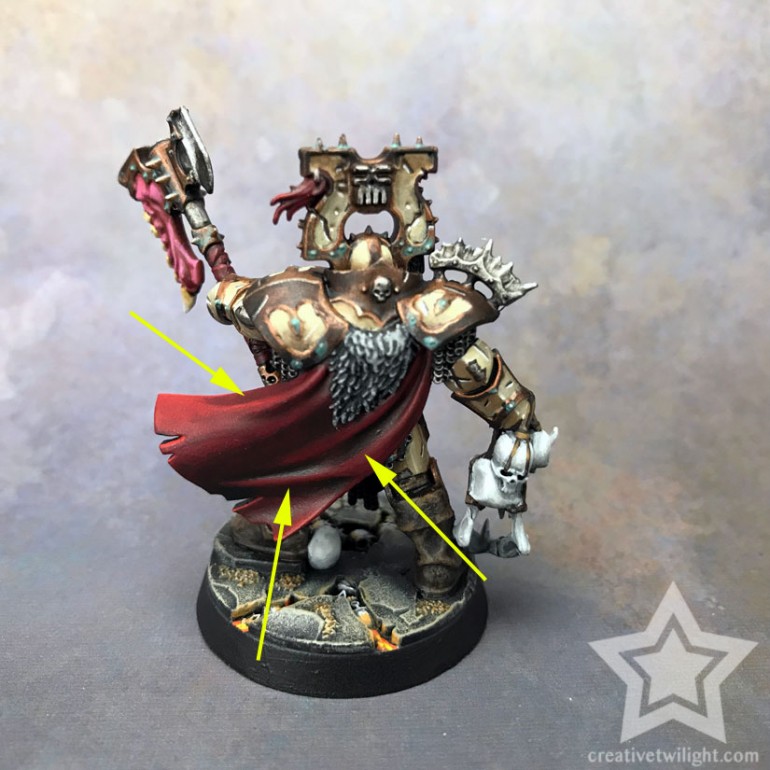
The arrows point at the loftier points, the folds, of the cloak. When I washed the cloak I pulled the brush towards those folds, depositing it in the lower areas, and shading it as you can see above.
Here's another example but on mankind.
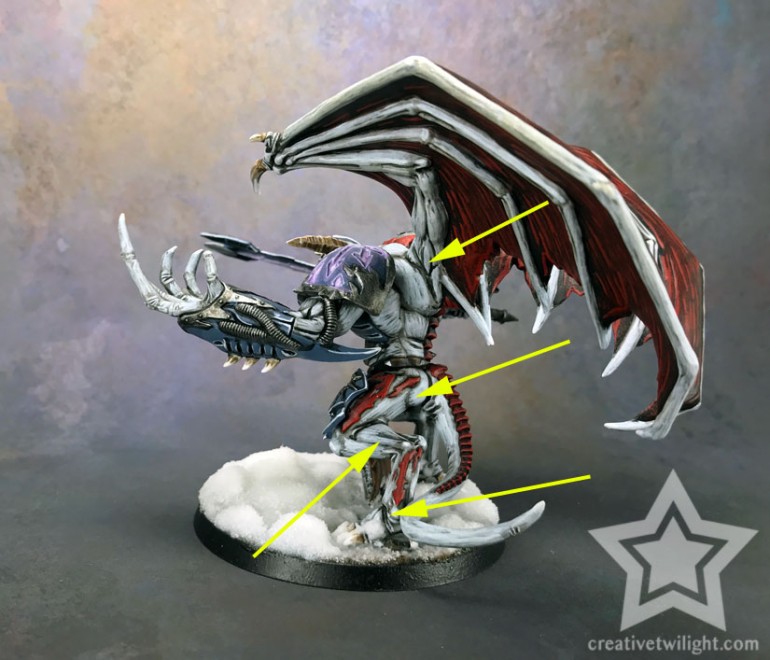
Again, using the arrows I'k showing some of the areas I pulled the brush towards to let the shading build up.
Recollect of it like wood, if you lot're familiar with woodworking, and y'all want to go against the grain.
Video Tutorial for Washes
I recently did a quick'ish video showing how to utilize a launder. Information technology covers nearly of what'south mentioned in this article, though this commodity does go in depth a flake more.
Layering and Cleaning Upwardly a Launder
Information technology's also worth mentioning that in both of those examples I painted other layers of paint after I washed the expanse.
Meet, there'south two common approaches when you're using a wash. One is to simply apply information technology to the surface area and call it good. Another arroyo is to wash an area and then to layer information technology up later on; typically with the same base glaze color.
So, the Daemon Prince above, I painted the mankind a blueish-white color. I then washed it all with black. Afterwards, I came back with that same blue-white and layered the skin while leaving the recesses shaded. That's how you lot become a overnice make clean look.
In fact, everything on that Daemon Prince was washed and then layered up: armor, wings, skin, horns, etc.
I did the same for that red cloak above likewise. It was base coated in red and done with a brown. I then layered cherry-red over it after to clean information technology upwardly and bring the color support.
Miniature Washing Tips
Some useful tips and advice I've learned over the years. I've made a lot of mistakes while learning, then perchance I tin salvage some of y'all those headaches.
Also, information technology gets a footling technical below and in that location's some painting terminology being used. If yous're unfamiliar with some of the terms then be sure to check out my glossary of miniature painting terms.
Don't Get As well Heavy
Most of the time you don't want to go too heavy with a wash. It's better to practice it lighter a few times to go it just right than to put too much on and have information technology not look right.
That being said, most of the time I only detect I need i glaze. One time y'all've done it quite a bit then you get the hang of how much you need without overdoing information technology.
If y'all go likewise heavy then the wash can puddle up too much in areas and instead of shading it, it will alter the color to that of the launder y'all used. Cypher wrong with that if it'southward your intent, but it sucks when it'south not.
With that, in one case yous've applied it to the areas you desire information technology, glance over it before you fix it downwards to dry out. Make certain there's no areas with too much launder. The launder will naturally move around a bit while you lot're painting (more on that beneath).
If you see an expanse that has too much on information technology and then but grab your castor and drag information technology around to sparse out that spot. You lot do want to do this quickly though. If the wash has started to dry, and you drag your brush over the area, then y'all're going to lift the pigment from the model and create a bare spot.
There's no piece of cake undo with washes once information technology's dried on your miniature. If yous mess upwards then yous'll need to repaint that area and try again. You can utilize blending techniques to right some issues, simply it's often a long and tedious process; been there, done that, and information technology sucks.
Thin Out the Wash for More than Control
If yous desire fifty-fifty more control with your washes then add in some Lahmian Medium, or another acrylic pigment medium.
What this does is thins it out and gives you much better control over it. The medium will break down the surface tension in the wash and spread out the pigment more. It'due south nifty for very thin coats with fine control.
Basically, it turns it into a glaze at that indicate.

By using a medium like this, it also lets y'all exercise some blending pretty hands. Yous'll be able to utilise multiple thin layers in succession to create a blend. This would be similar to the blending technique I like to use but instead uses washes. It's actually how I started learning to blend.
Using Washes for Skin
One of my favorite means to pigment homo skin is by using a thinned out flesh wash, similar Reikland Fleshshade. Past adding the Lahmian Medium and thinning it out, it lets me become the shading but right by doing a few thin coats.
I detect direct wash over human skin tones doesn't look very proficient; it's ofttimes a chip too stiff and also too dark. So, I thin it out and build information technology up as needed.
Here'south two examples:
Washing Large Apartment Surfaces
Using a medium is too platonic if yous're trying to wash large areas. Trying to wash something with large apartment surfaces, like a tank, tin can come out looking splotchy. It's just hard to movement the wash around evenly and go a consistent coat on the model. Notwithstanding, with a medium you'll thin information technology out and take more than control. It makes you less likely to take splotchy looking areas.
Some painters will even employ a driblet of dish detergent in their washes. Like a medium, the dish detergent will break the surface tension and allow for more than even coverage.
Work in Sections, Not All at One time
While it does take a little time for a wash to fully dry, y'all do want to move quickly when applying it. In simply a few minutes it tin start to dry in areas. If you're still moving your brush effectually then you tin can hit one of those drying spots and lift the paint; in turn ruining everything. Information technology sucks.
To avert that I like to work in sections. And then, using that Daemon pictured above, doing one arm upwards to the shoulder pad is a good section. Because the model is wearing a tabard of sorts, from the waist downward is some other good section.
Newton'southward Law of Gravity
The other reason to piece of work in section is gravity. Gravity is going to pull the wash down, which is pretty naturally how shading works – non in every state of affairs of course, but mostly.
Then, if you're washing a lot of sections at once then y'all're moving and tipping the model to reach different areas. While yous're doing that, the launder you've already practical is also moving around on the miniature. The result tin be information technology drying in places it wasn't intended to be, like running into parts of the model it wasn't meant for, or simply drying in an unnatural way.
That's the biggest reason I like to piece of work in sections, to let my wash dry naturally without existence moved around too much. It takes more than time when you're working on the model to work in sections, but you're less probable to have whatsoever mistakes besides.
Choose the Right Color
This is more of a color theory thing but it's yet worth mentioning.
As I said above, you tin go away with just a black and brown launder to start. However, it is nice to eventually accept most of the basics covered and have a choice to cull from.
The reason I say that is you can get some actually interesting looks with certain washes over certain base coats. Also, virtually colors tend to be a darker version of themselves, so using a black over ruby works but it's non ideal.
Speaking of, an example would be that using a green launder over a red base coat gives you a very natural looking darker red. You can even apply a purple for an interesting look.
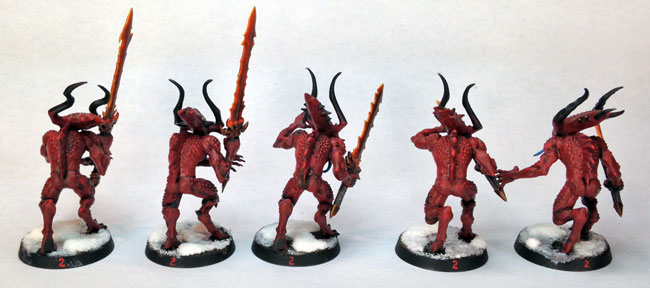
Besides, using a blueish over light-green can give a more natural shade as well. I like using a purple or ruddy over gold metallics to actually give information technology an interesting depth.
In fact, Sable Warlord did a smashing tutorial on painting gold where he shows his use of washes for a bully event.
I volition admit that color theory is non my potent adjust at all, so I larn a lot near this from experimenting – basic trial and error. My bespeak is more about trying something different and realizing that shadows aren't only black.
How to Make Your Ain Wash
If you mix in some Lahmian Medium, or some other acrylic medium, with a normal layer paint and then you tin create a launder from information technology. I observe a ratio of 50/50 works pretty well for about paints.
So, you aren't stuck with the colors that companies put out, you can create your own washes for your miniatures to suit your needs. I do this quite a bit and is just another reason why I honey Lahmian Medium.
Painting a Miniature with Only Washes
This is something I've done a few times and I love doing it – painting a miniature with merely washes.
How y'all exercise information technology is very, very unproblematic. Beginning, yous prime number your miniature in white. Yous could utilize grey primer also, depending on the tones you want, but I like to employ white because y'all can darken it all you want but you tin can't lighten a color with a wash.
Later the model is primed, but wash abroad!
You'll need a adept selection of washes to brand this work well, or brand your own, and oftentimes you'll need a few layers of different washes to get the desired color, but that'south part of the fun I feel. You only experiment and have fun with information technology.
Here's a few miniatures I've painted in this way to give you an idea of what you lot can accomplish with just washes. I did besides use some glazes in these, besides as a little dry brushing for highlights. All very basic techniques.
Tabletop Quality Painting with Washes
This is a video I shot in 2013, so a while ago. It's actually the first video I e'er did for Artistic Twilight.
Anyway, the video shows me painting a Grot with washes for some quick and easy tabletop quality work. In that location's some tips and advice in there equally well.
Decision
If you lot're a new miniature painter and so definitely endeavour washes. It's easy to get some good-looking shading on your models with minimal attempt. Even if you're a veteran painter you should consider using washes if y'all haven't. Information technology'southward a huge fourth dimension saver when you lot've got a lot to paint.
As well, it'south worth noting that as with other uncomplicated painting techniques, using washes for miniatures has a fleck of a stigma to it in the painting customs. Some people look down on information technology and experience that if you didn't spend hours shading your miniatures and then you lot're doing it wrong.
Ignore that crap. Pigment notwithstanding y'all want every bit long as you lot're happy doing information technology. Paint to please yourself and not everyone else. It's the consequence that matters, not the technique you used to get there.
For more tutorials cheque out the links beneath. I also accept a guide to miniature painting that serves as a singular resource for every painter.
Lastly, if yous're a new painter, or even a veteran, then cheque out my list of supplies every painter needs. That covers the basics that you need to have, every bit well every bit some premium tools that are handy when y'all can become effectually to it. You might discover something there you hadn't thought of before.
Anyone else accept some tips and advice for using washes on miniatures?
Miniature Painting Techniques & Guides
Learn the nuts, also equally the advanced techniques, of miniature painting.
- Author
- Recent Posts
Source: https://creativetwilight.com/washes/
Posted by: honakerfuleat.blogspot.com

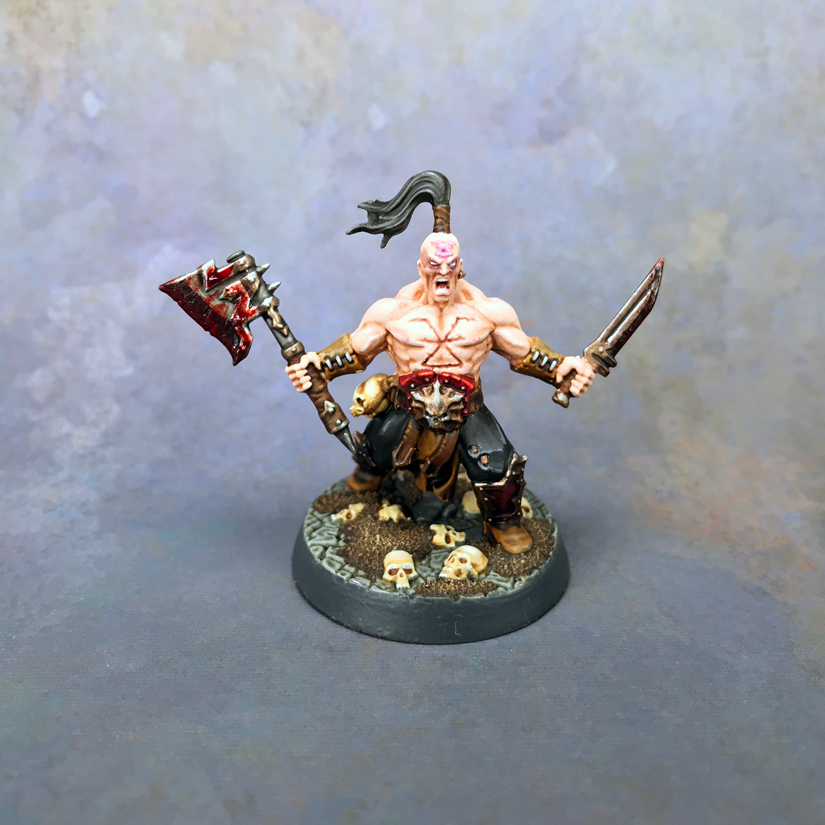
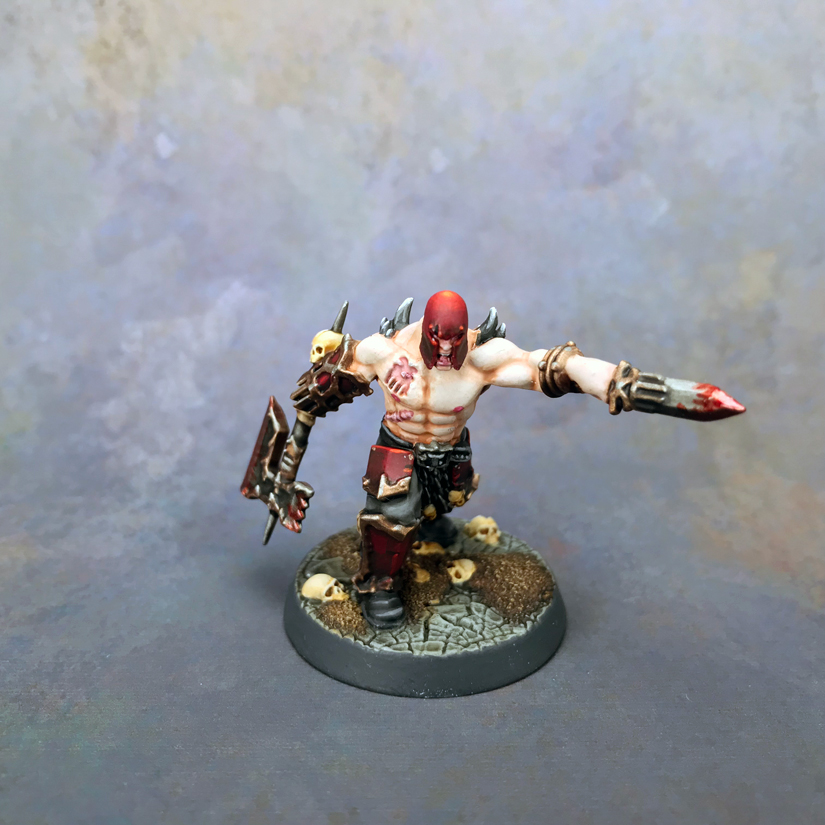
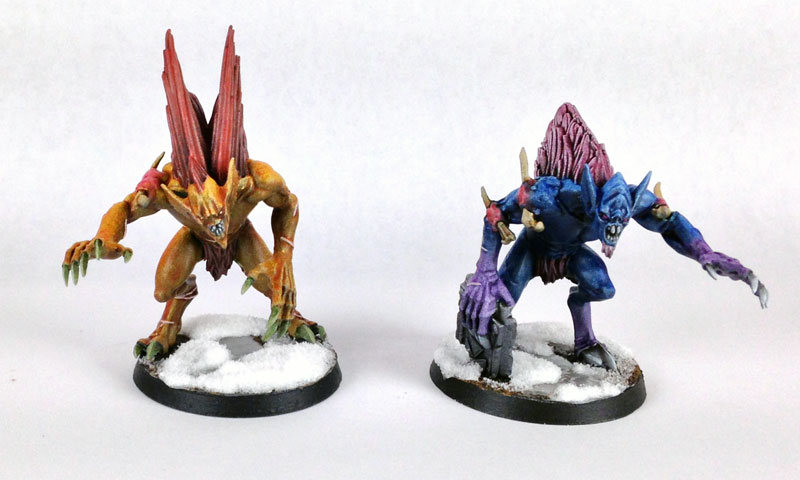
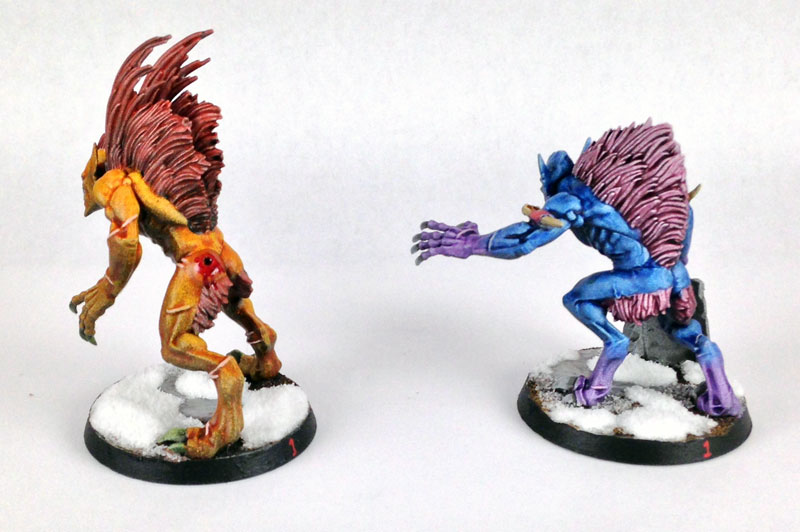


0 Response to "How To Make A Paint Wash"
Post a Comment